front MITSUBISHI LANCER 2005 Repair Manual
[x] Cancel search | Manufacturer: MITSUBISHI, Model Year: 2005, Model line: LANCER, Model: MITSUBISHI LANCER 2005Pages: 788, PDF Size: 45.98 MB
Page 192 of 788
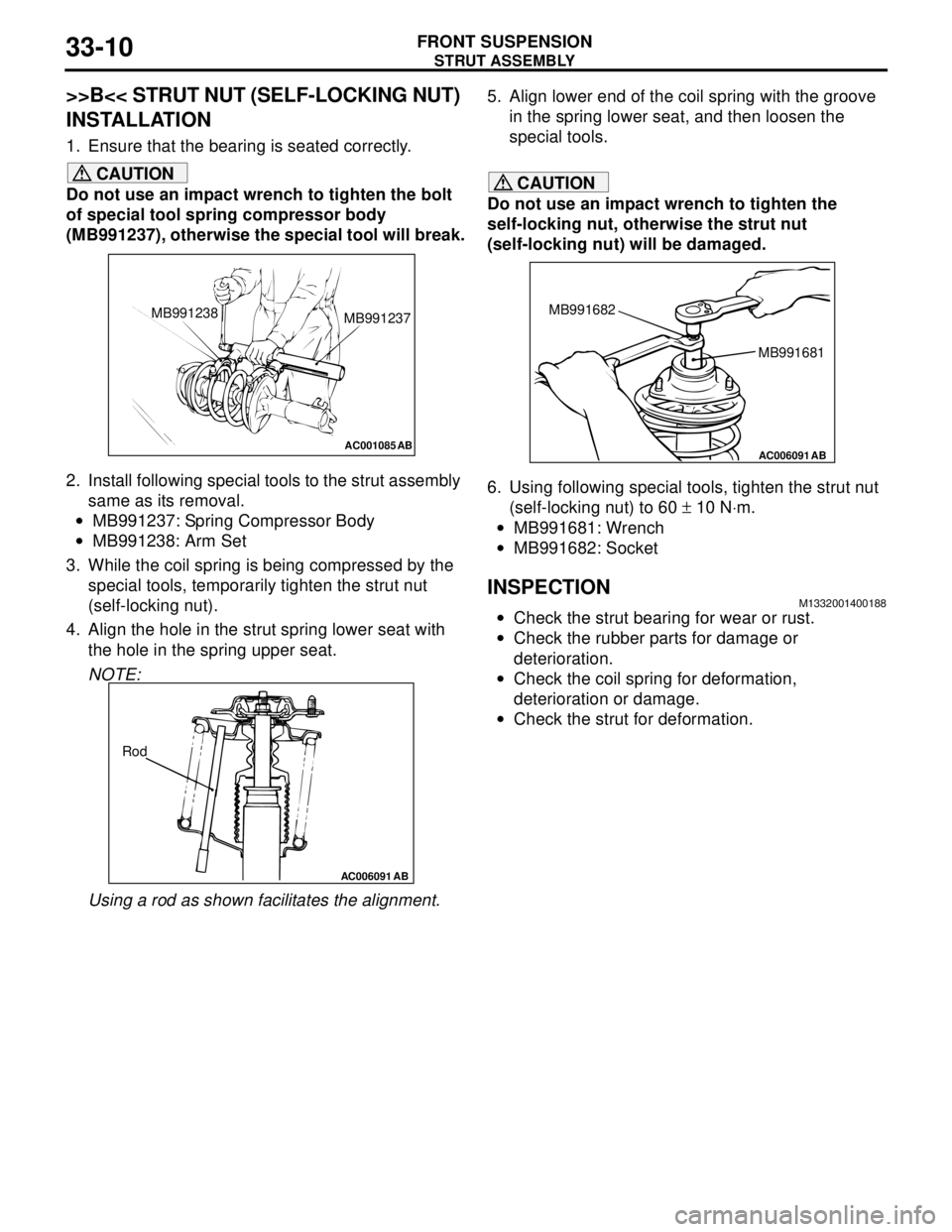
STRUT ASSEMBLY
FRONT SUSPENSION33-10
>>B<< STRUT NUT (SELF-LOCKING NUT)
INSTALLATION
1. Ensure that the bearing is seated correctly.
CAUTION
Do not use an impact wrench to tighten the bolt
of special tool spring compressor body
(MB991237), otherwise the special tool will break.
2. Install following special tools to the strut assembly
same as its removal.
•MB991237: Spring Compressor Body
•MB991238: Arm Set
3. While the coil spring is being compressed by the
special tools, temporarily tighten the strut nut
(self-locking nut).
4. Align the hole in the strut spring lower seat with
the hole in the spring upper seat.
NOTE:
Using a rod as shown facilitates the alignment.5. Align lower end of the coil spring with the groove
in the spring lower seat, and then loosen the
special tools.CAUTION
Do not use an impact wrench to tighten the
self-locking nut, otherwise the strut nut
(self-locking nut) will be damaged.
6. Using following special tools, tighten the strut nut
(self-locking nut) to 60 ± 10 N⋅m.
•MB991681: Wrench
•MB991682: Socket
INSPECTIONM1332001400188
•Check the strut bearing for wear or rust.
•Check the rubber parts for damage or
deterioration.
•Check the coil spring for deformation,
deterioration or damage.
•Check the strut for deformation.
AC001085 AB
MB991238
MB991237
AC006091 AB
Rod
AC006091 AB
MB991681 MB991682
Page 193 of 788
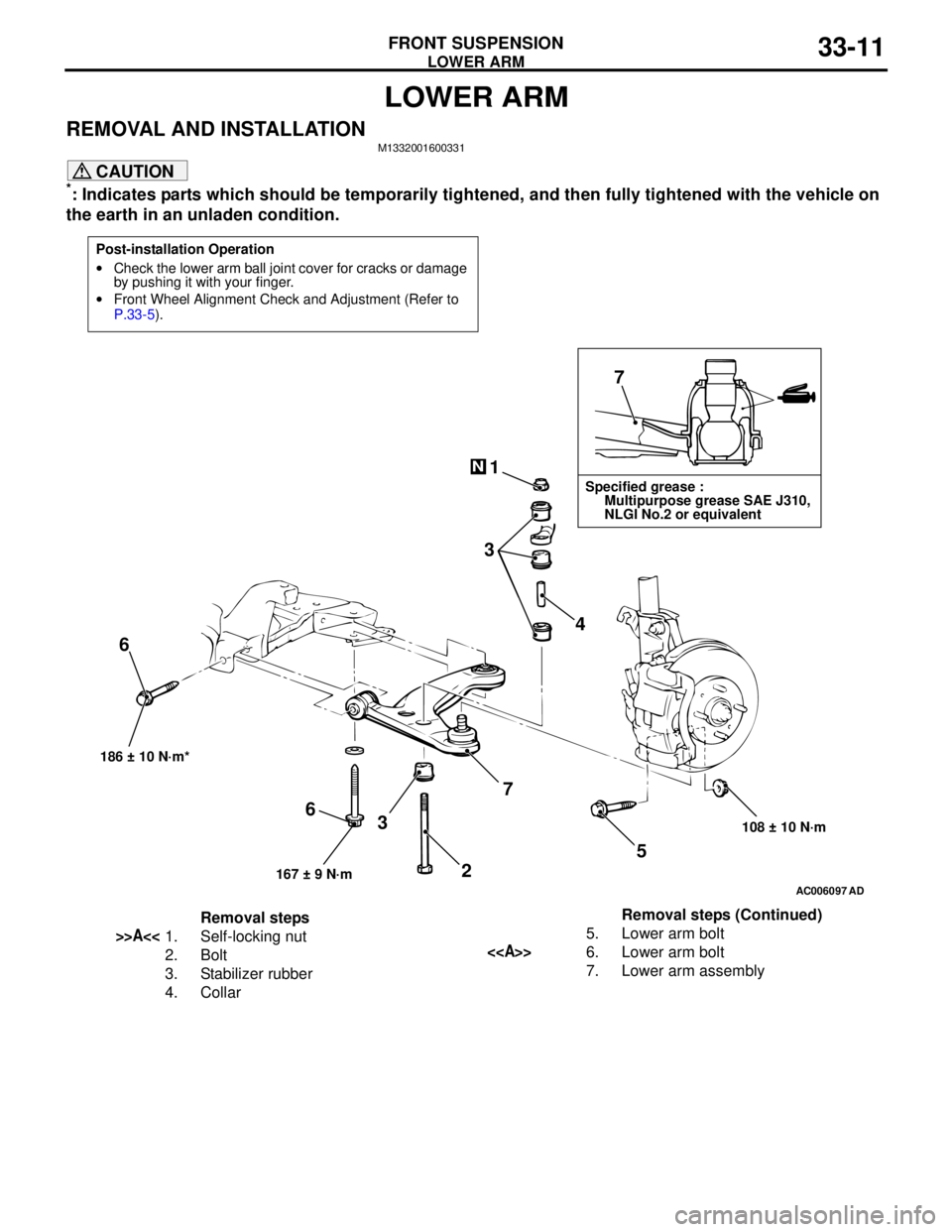
LOWER ARM
FRONT SUSPENSION33-11
LOWER ARM
REMOVAL AND INSTALLATIONM1332001600331
CAUTION
*: Indicates parts which should be temporarily tightened, and then fully tightened with the vehicle on
the earth in an unladen condition.
Post-installation Operation
•Check the lower arm ball joint cover for cracks or damage
by pushing it with your finger.
•Front Wheel Alignment Check and Adjustment (Refer to
P.33-5).
AC006097AD
7
1
3
4
5
108 ± 10 N·m 186 ± 10 N·m*
7
3 6
N
Specified grease :
Multipurpose grease SAE J310,
NLGI No.2 or equivalent
167 ± 9 N·m
6
2
Removal steps
>>A<<1. Self-locking nut
2. Bolt
3. Stabilizer rubber
4. Collar5. Lower arm bolt<>6. Lower arm bolt
7. Lower arm assemblyRemoval steps (Continued)
Page 194 of 788
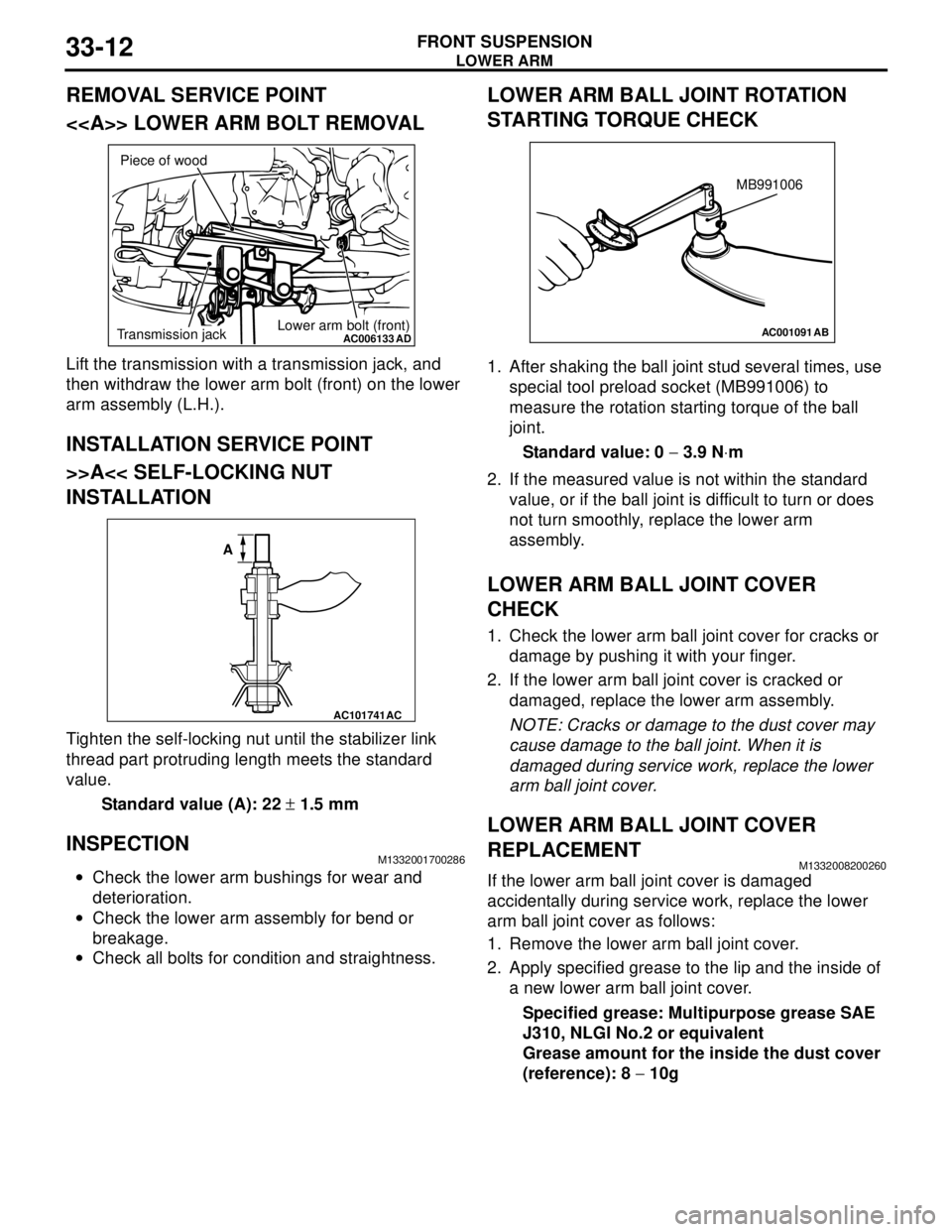
Page 195 of 788
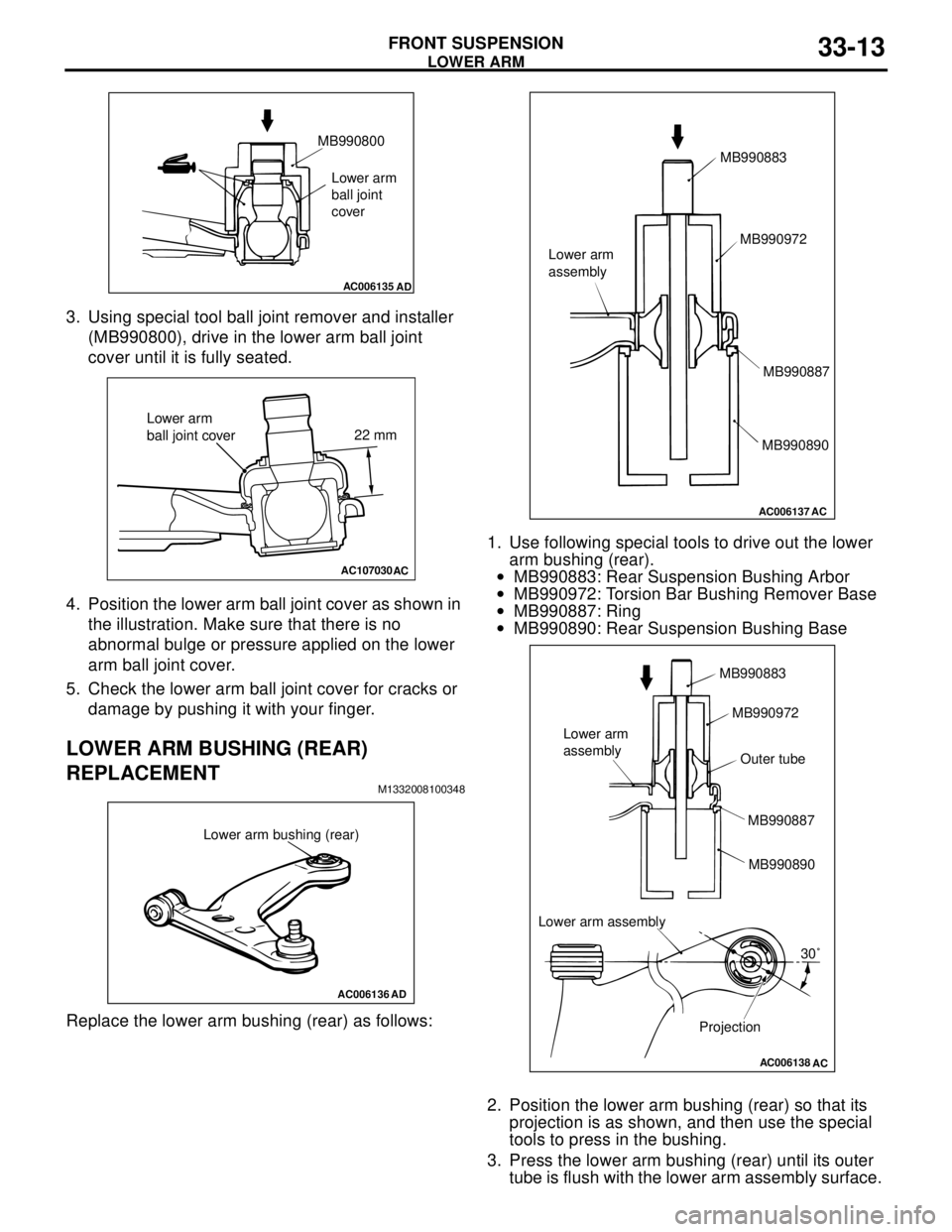
LOWER ARM
FRONT SUSPENSION33-13
3. Using special tool ball joint remover and installer
(MB990800), drive in the lower arm ball joint
cover until it is fully seated.
4. Position the lower arm ball joint cover as shown in
the illustration. Make sure that there is no
abnormal bulge or pressure applied on the lower
arm ball joint cover.
5. Check the lower arm ball joint cover for cracks or
damage by pushing it with your finger.
LOWER ARM BUSHING (REAR)
REPLACEMENT
M1332008100348
Replace the lower arm bushing (rear) as follows:1. Use following special tools to drive out the lower
arm bushing (rear).
•MB990883: Rear Suspension Bushing Arbor
•MB990972: Torsion Bar Bushing Remover Base
•MB990887: Ring
•MB990890: Rear Suspension Bushing Base
2. Position the lower arm bushing (rear) so that its
projection is as shown, and then use the special
tools to press in the bushing.
3. Press the lower arm bushing (rear) until its outer
tube is flush with the lower arm assembly surface.
AC006135
AD
MB990800
Lower arm
ball joint
cover
AC107030AC
22 mm
Lower arm
ball joint cover
AC006136
AD
Lower arm bushing (rear)
AC006137
AC
MB990883
MB990972
MB990887
MB990890 Lower arm
assembly
AC006138
AC
MB990883
MB990972
MB990887
MB990890 Lower arm
assembly
Projection30˚ Lower arm assemblyOuter tube
Page 196 of 788
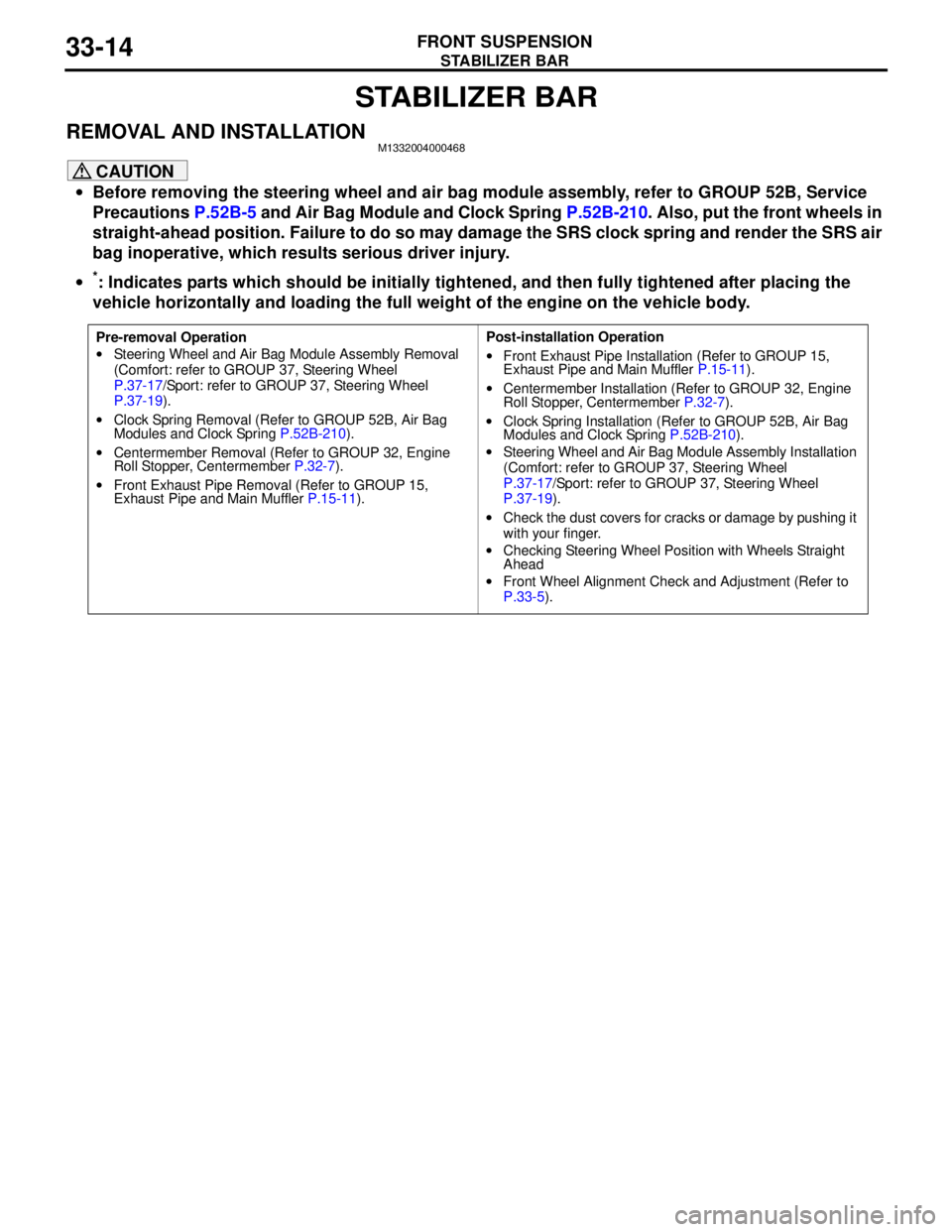
STABILIZER BAR
FRONT SUSPENSION33-14
STABILIZER BAR
REMOVAL AND INSTALLATIONM1332004000468
CAUTION
•Before removing the steering wheel and air bag module assembly, refer to GROUP 52B, Service
Precautions P.52B-5 and Air Bag Module and Clock Spring P.52B-210. Also, put the front wheels in
straight-ahead position. Failure to do so may damage the SRS clock spring and render the SRS air
bag inoperative, which results serious driver injury.
•
*: Indicates parts which should be initially tightened, and then fully tightened after placing the
vehicle horizontally and loading the full weight of the engine on the vehicle body.
Pre-removal Operation
•Steering Wheel and Air Bag Module Assembly Removal
(Comfort: refer to GROUP 37, Steering Wheel
P.37-17/Sport: refer to GROUP 37, Steering Wheel
P.37-19).
•Clock Spring Removal (Refer to GROUP 52B, Air Bag
Modules and Clock Spring P.52B-210).
•Centermember Removal (Refer to GROUP 32, Engine
Roll Stopper, Centermember P.32-7).
•Front Exhaust Pipe Removal (Refer to GROUP 15,
Exhaust Pipe and Main Muffler P.15-11).Post-installation Operation
•Front Exhaust Pipe Installation (Refer to GROUP 15,
Exhaust Pipe and Main Muffler P.15-11).
•Centermember Installation (Refer to GROUP 32, Engine
Roll Stopper, Centermember P.32-7).
•Clock Spring Installation (Refer to GROUP 52B, Air Bag
Modules and Clock Spring P.52B-210).
•Steering Wheel and Air Bag Module Assembly Installation
(Comfort: refer to GROUP 37, Steering Wheel
P.37-17/Sport: refer to GROUP 37, Steering Wheel
P.37-19).
•Check the dust covers for cracks or damage by pushing it
with your finger.
•Checking Steering Wheel Position with Wheels Straight
Ahead
•Front Wheel Alignment Check and Adjustment (Refer to
P.33-5).
Page 197 of 788
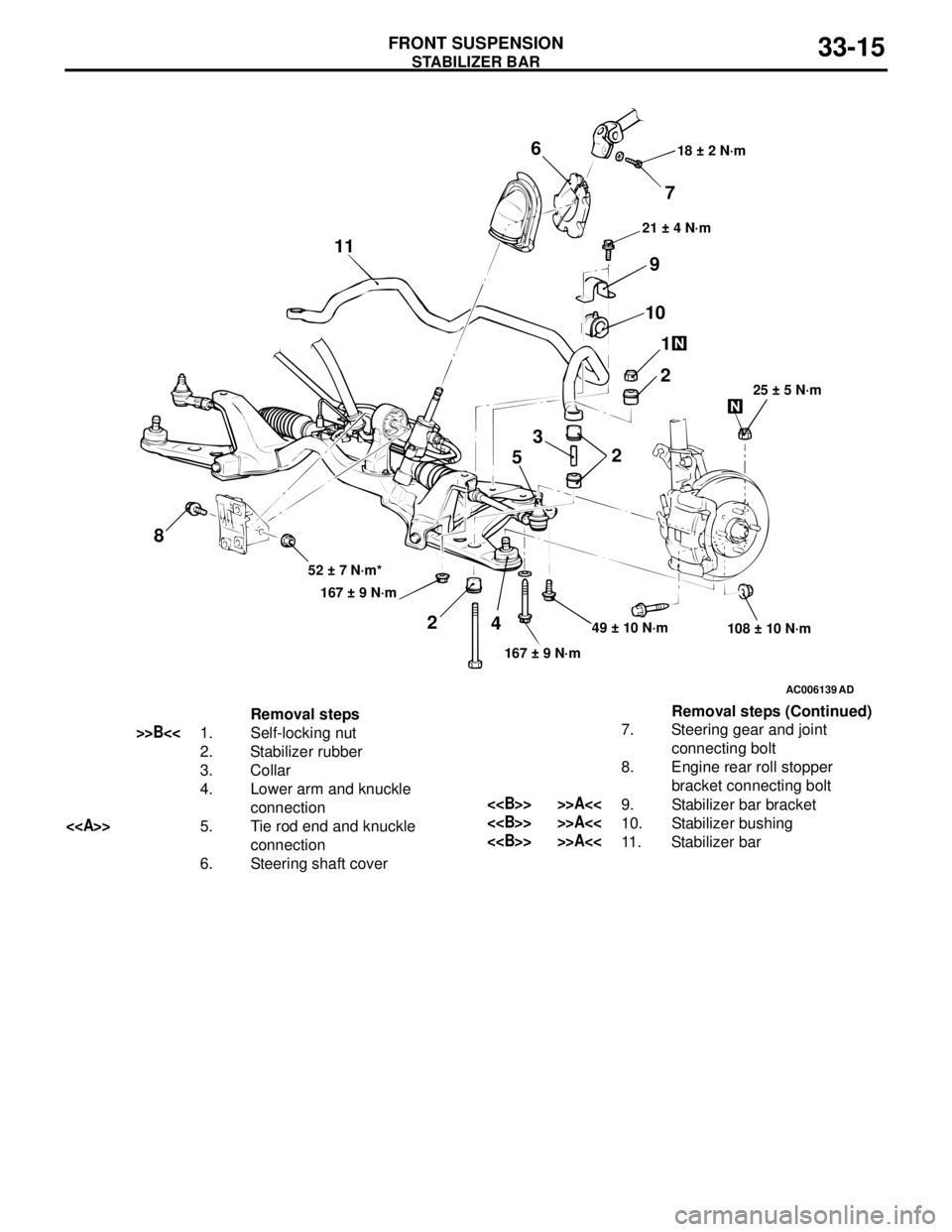
STABILIZER BAR
FRONT SUSPENSION33-15
AC006139
AD
49 ± 10 N·m
108 ± 10 N·m
167 ± 9 N·m 167 ± 9 N·m 52 ± 7 N·m*25 ± 5 N·m 21 ± 4 N·m 18 ± 2 N·m
7 6
9
10
1
2
2 3
5
4 2 11
8
Removal steps
>>B<<1. Self-locking nut
2. Stabilizer rubber
3. Collar
4. Lower arm and knuckle
connection
<>5. Tie rod end and knuckle
connection
6. Steering shaft cover7. Steering gear and joint
connecting bolt
8. Engine rear roll stopper
bracket connecting bolt
<> >>A<<9. Stabilizer bar bracket
<> >>A<<10. Stabilizer bushing
<> >>A<<11. Stabilizer barRemoval steps (Continued)
Page 198 of 788
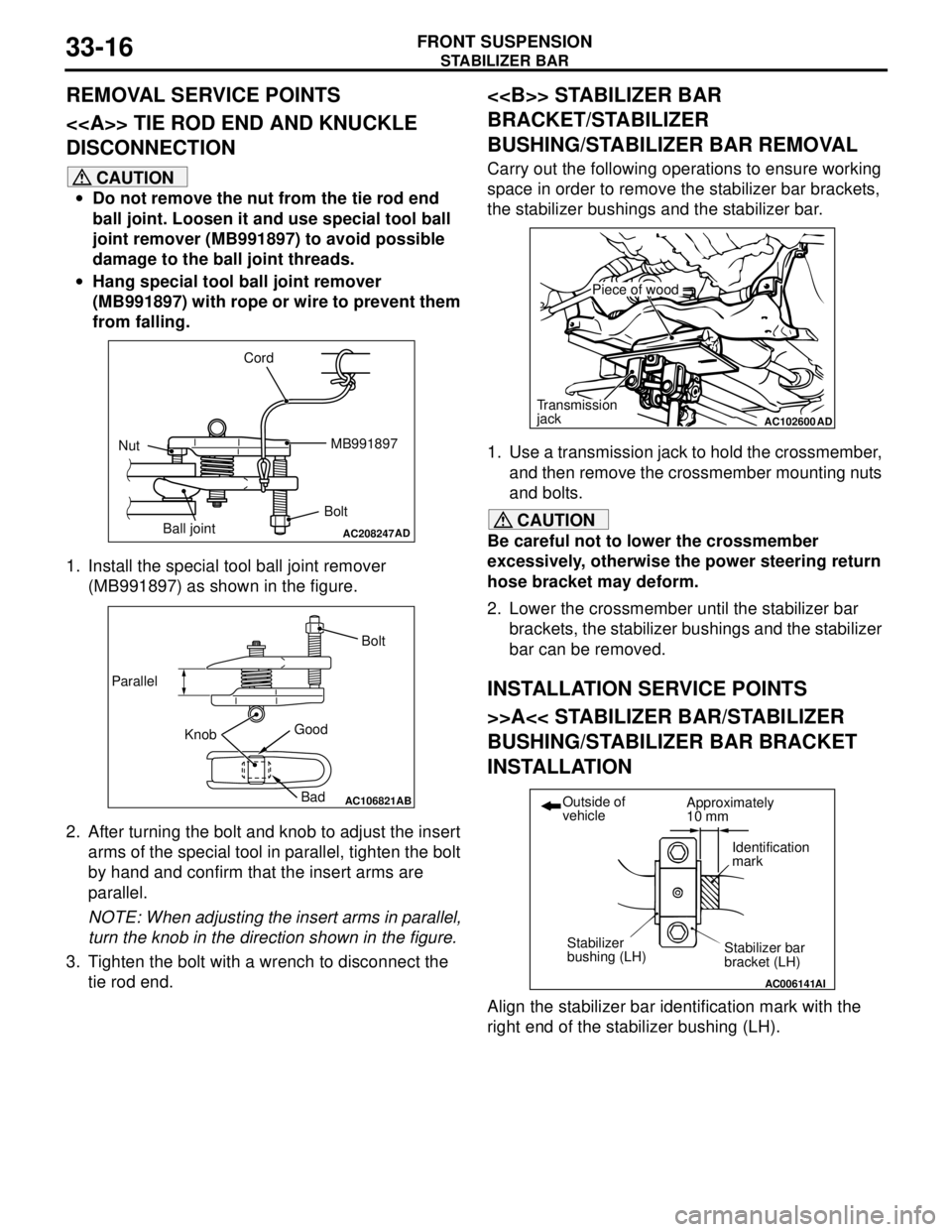
Page 199 of 788
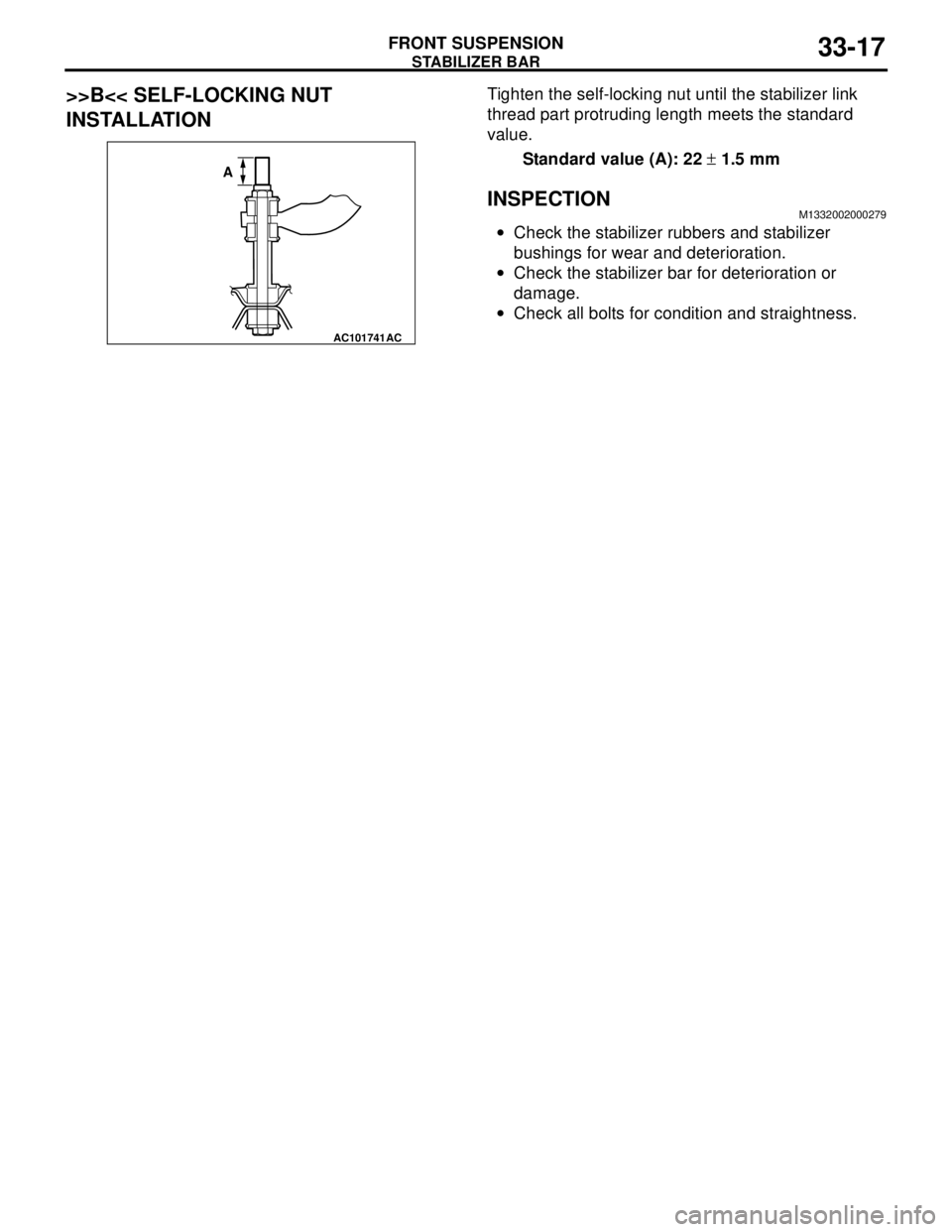
STABILIZER BAR
FRONT SUSPENSION33-17
>>B<< SELF-LOCKING NUT
INSTALLATIONTighten the self-locking nut until the stabilizer link
thread part protruding length meets the standard
value.
Standard value (A): 22 ± 1.5 mm
INSPECTIONM1332002000279
•Check the stabilizer rubbers and stabilizer
bushings for wear and deterioration.
•Check the stabilizer bar for deterioration or
damage.
•Check all bolts for condition and straightness.
AC101741AC
A
Page 206 of 788
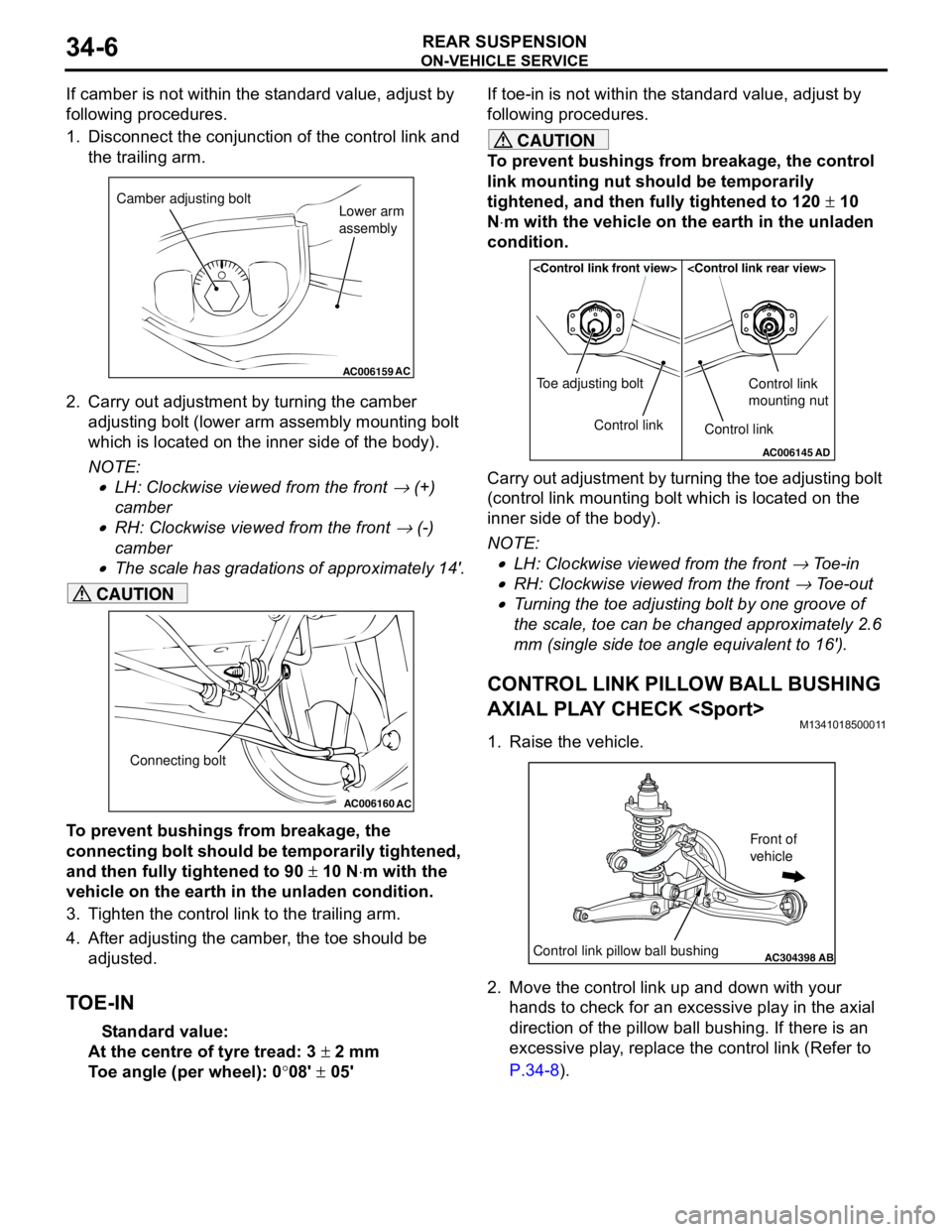
ON-VEHICLE SERVICE
REAR SUSPENSION34-6
If camber is not within the standard value, adjust by
following procedures.
1. Disconnect the conjunction of the control link and
the trailing arm.
2. Carry out adjustment by turning the camber
adjusting bolt (lower arm assembly mounting bolt
which is located on the inner side of the body).
NOTE: .
•LH: Clockwise viewed from the front → (+)
camber
•RH: Clockwise viewed from the front → (-)
camber
•The scale has gradations of approximately 14'.
CAUTION
To prevent bushings from breakage, the
connecting bolt should be temporarily tightened,
and then fully tightened to 90 ± 10 N⋅m with the
vehicle on the earth in the unladen condition.
3. Tighten the control link to the trailing arm.
4. After adjusting the camber, the toe should be
adjusted.
TOE-IN
Standard value:
At the centre of tyre tread: 3 ± 2 mm
Toe angle (per wheel): 0°08' ± 05'If toe-in is not within the standard value, adjust by
following procedures.
CAUTION
To prevent bushings from breakage, the control
link mounting nut should be temporarily
tightened, and then fully tightened to 120 ± 10
N⋅m with the vehicle on the earth in the unladen
condition.
Carry out adjustment by turning the toe adjusting bolt
(control link mounting bolt which is located on the
inner side of the body).
NOTE: .
•LH: Clockwise viewed from the front → Toe-in
•RH: Clockwise viewed from the front → Toe-out
•Turning the toe adjusting bolt by one groove of
the scale, toe can be changed approximately 2.6
mm (single side toe angle equivalent to 16').
CONTROL LINK PILLOW BALL BUSHING
AXIAL PLAY CHECK
M1341018500011
1. Raise the vehicle.
2. Move the control link up and down with your
hands to check for an excessive play in the axial
direction of the pillow ball bushing. If there is an
excessive play, replace the control link (Refer to
P.34-8).
AC006159AC
Camber adjusting bolt
Lower arm
assembly
AC006160
AC
Connecting bolt
AC006145AD
Control link Toe adjusting boltControl link
Control link
mounting nut
AC304398ABControl link pillow ball bushing
Front of
vehicle
Page 207 of 788

ON-VEHICLE SERVICE
REAR SUSPENSION34-7
UPPER ARM PILLOW BALL BUSHING
AXIAL PLAY CHECK
M1341018400014
1. Raise the vehicle.
2. Move the upper arm up and down with your hands
to check for an excessive play in the axial
direction of the pillow ball bushing. If there is an
excessive play, replace the upper arm (Refer to
P.34-8).
LOWER ARM PILLOW BALL BUSHING
AXIAL PLAY CHECK
M1341016900057
1. Raise the vehicle.
2. Remove the stabilizer link and shock absorber
from the lower arm assembly.3. Move the lower arm up and down with your hands
to check for an excessive play in the axial
direction of the pillow ball bushing. If there is an
excessive play, replace the lower arm pillow ball
bushing (Refer to P.34-10).
4. After inspection, install the stabilizer link and
shock absorber to the lower arm assembly (Refer
to P.34-8).
STABILIZER LINK BALL JOINT DUST
COVER INSPECTION
M1341012800274
1. Check stabilizer link ball joint dust covers for
cracks or damage by pushing it with your finger.
2. If a dust cover is cracked or damaged, replace the
stabilizer link assembly.
NOTE: Cracks or damage to the dust cover may
cause damage to the ball joint.
AC304398AC
Upper arm pillow
ball bushing
Front of
vehicle
AC304398ADLower arm pillow ball bushing
Front of
vehicle